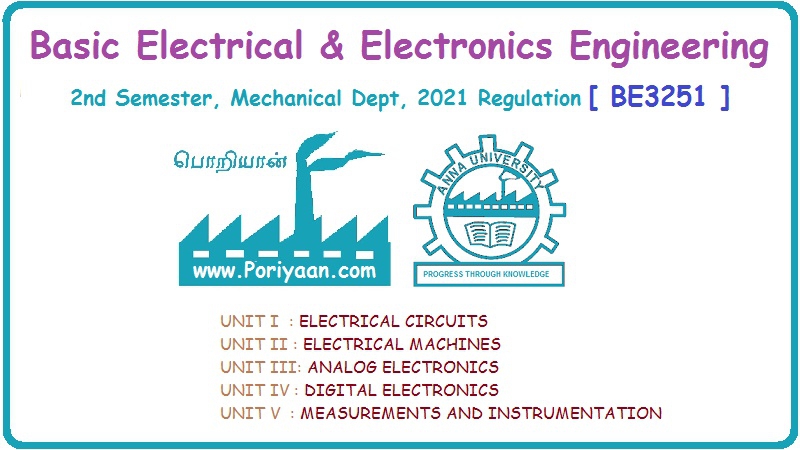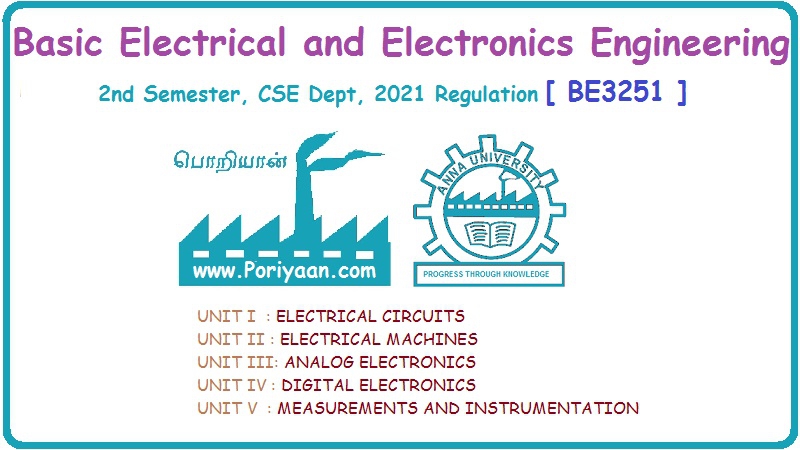Basic Electrical and Electronics Engineering: Unit II: Electrical Machines
Construction of Transformer
The simple elements of a transformer consists of two coils having mutual inductance and a laminated steel core.
CONSTRUCTION
OF TRANSFORMER
The
simple elements of a transformer consists of two coils having mutual inductance
and a laminated steel core. The two coils are insulated from each other and the
steel core other necessary parts are core and windings. In all types of
transformers, the core is constructed of transformer sheet steel laminations
assembled to provide a continuous magnetic path with a minimum of air-gap
included.
The
steel used is of high silicon content, sometimes heat treated to produce a high
permeability and a low hysteresis loss at the usual operating flux densities.
The eddy current loss is minimized by laminating the core, the laminations
being insulated from each other by a light coat of core-plate varnish (or) by
an oxide layer on the surface. The thickness of laminations varies from 0.35 mm
to 0.5 mm. The core laminations are joined as shown in Figure 3.42 (b).
Constructionally,
the transformers are of two general types, distinguished from each other by in
which the primary and secondary coils are placed around the laminated core. The
two types are known as
(i)
Core type
(ii)
Shell type
In
both core and shell type transformers, the individual laminations are cut in
the form of long strips of 'L', 'E' and 'I' as shown in Figure 2.30.
The
assembly of the complete core for the two types of transformers as shown on
Figure 3.43.
Core-Type
Transformer
The
coils used are form-wound and are of the cylindrical type. The general form of
these coils may be circular (or) oval (or) rectangular. In small size core-type
transformers, a simple rectangular core is used with cylindrical coils which
are either circular (or) rectangular in form.
But
for large size core type transformers, round (or) circular cylindrical coils
are used which are so wound as to fit over a cruciform core section as shown in
Figure 2.32.
The
circular cylindrical coils are used in most of core-type transformer because of
their mechanical strength. Such cylindrical coils are wound in helical layers
with the different layers insulated from each other by paper, cloth, mica board
(or) cooling ducts.
Shell-Type
Transformers
In
these case also, the coils are form-wound but are multi-layer disc type usually
wound in the form of pancakes. The different layers of such multi-layer disc
are insulated from each other by paper. The complete winding consists of
stacked disc with insulation space between the coils-the spaces forming horizontal
cooling and insulating ducts. A shell type transformer may have a simple
rectangular form as shown in Figure 2.33.
A
very commonly used shell type transformer is the one known as Berry Transformer
so called after the name of its designer and is cylindrical in form. The
transformer core consists of laminations arranged in groups which radiate out
from the centre as shown in Figure 3.47.
It
may be pointed out that cores and coils of transformers must be provided with
rigid mechanical bracing in order to prevent movement and possible insulation
damage.
Good
bracing reduces vibration and the objectionable noise-a humming sound- during
operation.
The
spiral-core transformer employs the newest development in core construction.
The core is assembled of a continuous strip (or) ribbon of transformer steel
wound in the form of a circular (or) elliptical cylinder. Such construction
allows the core flux to follow the grain of the iron.
Transformers
are generally housed in lightly-fitted sheet-metal, tank filled with special
insulating oil. This oil has been highly developed and its function is
two-fold.
Basic Electrical and Electronics Engineering: Unit II: Electrical Machines : Tag: : - Construction of Transformer
Related Topics
Related Subjects
Basic Electrical and Electronics Engineering
BE3251 2nd semester Mechanical Dept | 2021 Regulation | 2nd Semester Mechanical Dept 2021 Regulation
Basic Electrical and Electronics Engineering
BE3251 2nd Semester CSE Dept 2021 | Regulation | 2nd Semester CSE Dept 2021 Regulation

